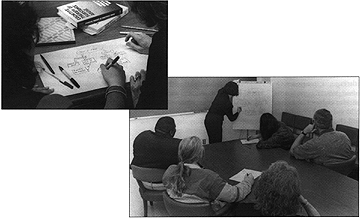 |
Research Advances
Volume 11, Number 2
March/April 1996 |
Study Finds Ways to Improve Drug Abuse Treatment Process
By Robert Mathias, NIDA NOTES Staff Writer
Scientific research has long established that drug abuse treatment can work. Now, a NIDA-funded treatment demonstration study is showing how drug abuse treatment can work better.
The Improving Drug Abuse Treatment for AIDS-Risk Reduction (DATAR) project is a large-scale study of opiate-addicted patients in three methadone treatment clinics in Texas. Conducted under the real-world constraints of these three community-based treatment programs, the study has been analyzing the drug abuse treatment process and developing new strategies and tools to improve the effectiveness of drug abuse treatment since 1989.
"The focus of DATAR's research has been what happens during treatment to influence outcomes," says Dr. Bennett Fletcher of NIDA's Division of Clinical and Services Research. "We've looked at how patients look coming into treatment and how they look coming out of treatment, but we haven't really focused on what happens to them during treatment to make them either succeed or fail," he says. Using structural modeling and sophisticated analytical strategies, "DATAR has been trying to tease out which variables in the treatment process are important in increasing engagement, reducing dropout, and improving the behaviors that are needed for suc-cessful treatment outcomes," he says.
Previous research has shown that the longer a patient stays in drug abuse treatment, the more effective the treatment and the better the posttreatment outcomes, says Dr. Dwayne Simpson, who directs both the project and the Institute of Behavioral Research at Texas Christian University. However, little has been known about how individual patient characteristics interact with different aspects of treatment to affect the length of a patient's stay in treatment. Studies conducted by DATAR researchers show that improvements in a patient's motivation, the therapeutic relationship between patient and counselor, the patient's engagement in treatment, and the patient's social environment outside treatment all have a positive effect on the length of time a patient stays in treatment and treatment outcomes, Dr. Simpson says.
 |
|
One of several interventions developed as part of the
DATAR project is a simple technique called node-link
mapping. These two pictures show counselors and patients
using this technique in individual and group counseling
sessions to write down and link all the aspects of a drug
abuse-related problem, making it easier for patients to see
the likely consequences of specific actions.
|
In addition to trying to determine how different aspects of treatment work together to affect time in treatment and outcomes, DATAR scientists wanted to develop new strategies that would improve the treatment process. This research has focused on using cognitive techniques in counseling sessions to strengthen the therapeutic relationship between counselors and patients, to promote greater patient engagement in treatment, and to reduce the rates at which patients drop out of treatment and relapse to drug use.
One treatment improvement the DATAR project has developed is a simple graphic technique called node-link mapping for counselors to use in treatment counseling sessions. Counselors and patients use the technique to write down and link all the aspects of a drug abuse-related problem, making it easier for patients to see the likely consequences of taking specific actions. DATAR studies show that this cognitive-enhancement technique is an important new clinical tool that improves the therapeutic relationship between counselor and patients and increases the effectiveness of drug abuse counseling sessions.
Resources
Researchers working in the DATAR project have also developed several psychoeducational intervention manuals for counselors to use to educate patients and build patients' skills in important areas that community-based programs often do not have the resources to address. These modules, which cover HIV/AIDS education, assertiveness training for women, and transition to aftercare, "provide information that is sorely needed in the populations they serve," Dr. Fletcher says. "The manuals are hands-on, get to the point, tell counselors what they need to know, and can be used with minimal preparation," Dr. Simpson notes.
Treatment programs can order copies of these intervention manuals for a nominal fee from Lighthouse Institute Publishing, Chestnut Health Systems, 402 West Chestnut, Bloomington, IL 61701, (309) 829-4661. Requests for additional information about DATAR may be faxed to the Institute of Behavioral Research at (817) 921-7290.
Sources
Simpson, D.D.; Dansereau, D.F; and Joe, G.W. The DATAR project: Cognitive and behavioral enhancements to community-based treatments. In: Tims, F.M.; Fletcher, B.W.; Inciardi, J.A.; Delany, P.; and Horton, A.M., eds. The Effectiveness of Innovative Strategies in the Treatment of Drug Abuse. Westport, CT: Greenwood, in press.
Simpson, D.D.; Joe, G.W.; Rowan-Szal, G.; and Greener, J. Client engagement and change during drug abuse treatment. Journal of Substance Abuse 7:117-134, 1995.
From NIDA NOTES, March/April, 1996
[NIDA Home Page][NIDA NOTES Index][1996 Archive Index Index]
|